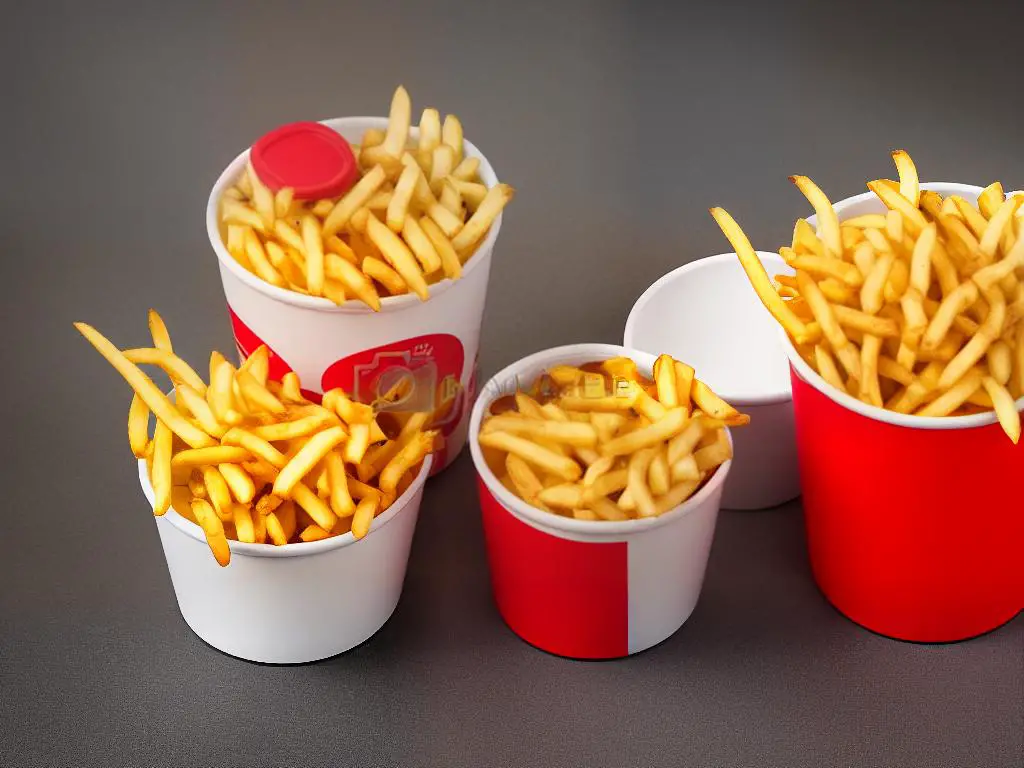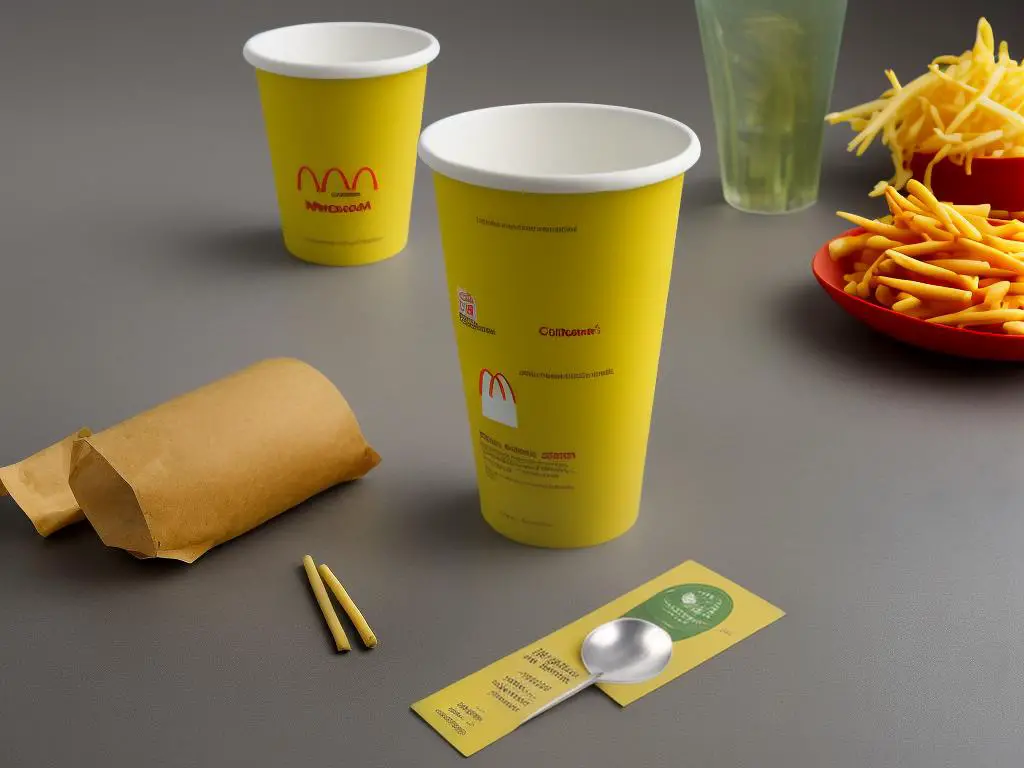McDonald’s has been a prominent player in the Chinese fast-food market since its inception, catering to the tastes and preferences of millions of Chinese consumers. One of their products that has found significant success in this vast market is the Corn Cup. This essay delves into the numerous factors that have contributed to the widespread popularity of this relatively simple item, encompassing aspects such as the cultural significance of corn, McDonald’s marketing pursuits, and the nutritional value of the Corn Cup.
History of McDonald’s in China
McDonald’s and Adapting to Local Tastes in China
In 1990, McDonald’s entered the Chinese market, opening its first restaurant in Shenzhen—a city that was often referred to as China’s “capital of reform.” At that time, its world-renowned fast-food menu was new to the Chinese population, proving to be an exciting experience for the locals. As McDonald’s continued its expansion in China, the company made an effort to cater to the local tastes and preferences of consumers by introducing menu items that were unique to the region. The now-popular McDonald’s China Corn Cup was added to the menu as a side dish to provide a traditional and healthier option for the locals.
The Art of Menu Localization
The development of McDonald’s Corn Cup in China reflects the company’s strategic plan in adapting its menu to the local preferences of a culturally rich and diverse nation. Throughout the years, McDonald’s has mastered the art of menu localization, carefully incorporating popular Chinese ingredients and flavours into its offerings. As such, the Corn Cup quickly gained popularity in the country, with many customers enjoying it as a light, yet satisfying accompaniment to their meals.
Rapid Growth in China
McDonald’s continued growth in China led to rapid expansion across the nation. By 2008, McDonald’s had opened more than 1,000 outlets in the country, and by 2020, that number had risen to over 3,500 locations. This tremendous growth was primarily driven by the company’s ability to cater to the wide-ranging tastes and preferences of the Chinese population. The Corn Cup offering is one example of how McDonald’s has managed to effectively adapt to the diverse palate of the Chinese consumer, whilst still maintaining its global appeal.
Impact on the Chinese Fast-Food Market
The introduction of McDonald’s in China and its subsequent fast-food culture has had a significant impact on the Chinese fast-food market as a whole. With the popularity of McDonald’s Corn Cup and its other products designed specifically for the Chinese market, it paved the way for other international and local fast-food chains to enter and adapt to this new market. Moreover, the convenience and affordability of fast-food offerings further contributed to the shift in Chinese eating habits, favouring more quick-service and on-the-go dining options.
Conclusion
McDonald’s journey in China has undeniably been transformative for the company and its patrons alike. The success of menu items like the McDonald’s China Corn Cup exemplifies how the fast-food giant has effectively customised its products to cater to local tastes. This level of cultural understanding and adaptation has undoubtedly played a pivotal role in the company’s growth and influence on the fast-food market in China. McDonald’s continues to demonstrate its commitment to serving its diverse clientele, a quality that is sure to sustain its popularity as it continues to expand within China and other emerging markets.

Introduction of the Corn Cup
Incorporating Local Flavours: McDonald’s Asia and the Corn Cup
In 2012, McDonald’s China introduced a rather unique menu item – the Corn Cup – as part of their strategy to cater to local tastes and preferences. This innovative product came to be when McDonald’s identified corn as a highly popular and nutritious ingredient amongst Chinese consumers. It is served in a small cup, not unlike the containers used for chips, filled with cooked sweetcorn kernels. The Corn Cup was initially launched on a trial basis in selected outlets across China, with the aim of gauging consumer response.
To say that the Corn Cup was well-received would be an understatement. As customers flocked to their local McDonald’s branches to try this new offering, the positive feedback and strong demand prompted the fast-food giant to launch the Corn Cup across all outlets in China. The move to incorporate this locally-inspired menu item was deemed a success, as it not only attracted new customers but also demonstrated McDonald’s ability to adapt its menu to cater to the tastes and preferences of different markets.
Sourcing and Symbolism
In an effort to ensure the highest quality for its customers, McDonald’s China sources its corn locally from Chinese agricultural producers. This also contributes to the local economy, fostering stronger connections between the fast-food giant and the Chinese agricultural industry. As a result, the Corn Cup is not only tasty but also holds symbolic value for Chinese consumers, becoming a symbol of McDonald’s commitment to incorporate local flavours and ingredients into their offerings.
Reinvention and Innovation
Over the years, McDonald’s China has continued to add various seasonal and special edition Corn Cups to their menu, all of which have continued to pique the interest of Chinese consumers. Some of these iterations have included the addition of different sauces or condiments, such as mustard or butter, while others have featured new corn preparations, like roasted or grilled. This continuous reinvention and innovation have helped maintain the popularity of the Corn Cup among Chinese customers.
A Global Impact
The Corn Cup has had a significant impact on McDonald’s global business strategy, demonstrating that catering to local tastes and preferences can yield success. As a result, it is probable that McDonald’s will continue to experiment with new flavours and ingredients that resonate with local consumers, whilst remaining true to their brand identity as a renowned fast-food chain. In support of this, the Corn Cup has been introduced to other Asia-Pacific markets, such as Taiwan and the Philippines, showcasing its value as a model for localised product offerings.

Nutritional Value of the Corn Cup
The Corn Cup: A Healthy Snack Option at McDonald’s China
As a healthy addition to the McDonald’s menu, specifically in China, the Corn Cup predominantly consists of sweet corn kernels. According to the information available on their official website, one serving of McDonald’s China Corn Cup contains approximately 113 calories, making it a relatively low-calorie snack option compared to other menu items, such as fries or burgers. The caloric content primarily derives from the carbohydrates present in the corn kernels.
Micronutrients in the Corn Cup
In terms of the micronutrients, corn is a good source of essential vitamins and minerals. One 100g serving of the McDonald’s China Corn Cup, for example, provides almost 10% of the daily recommended value of vitamin C. This vitamin is important for the growth, development, and repair of all body tissues, as well as the absorption of iron and the maintenance of a strong immune system. Additionally, corn contains several of the B complex vitamins, such as thiamin, niacin, and folate, which contribute to energy production, nervous system function, and cell growth, respectively.
Dietary Fiber in the Corn Cup
The Corn Cup also has a significant amount of dietary fiber. On average, a serving of this product will provide roughly 2.3 grams of dietary fiber, which equates to around 9% of the daily recommended value for an adult. Consuming adequate fiber is integral to maintaining a healthy digestive system and preventing constipation, as well as lowering the risk of heart disease and type 2 diabetes by regulating blood sugar levels and cholesterol. Furthermore, fiber can help with weight management by contributing to a feeling of fullness and reducing calorie intake.
Benefits of Corn and the Corn Cup
Corn is a naturally gluten-free food, so the McDonald’s China Corn Cup is an ideal snack option for those with gluten sensitivities or celiac disease. Additionally, research has suggested that corn contains certain bioactive compounds such as carotenoids, phenolic compounds, and phytosterols. These compounds possess antioxidants and anti-inflammatory properties that can contribute to overall health and potentially lower the risk of chronic diseases.
Moderation is Key
It is crucial to consider that the Corn Cup should be consumed in moderation as part of a well-balanced and diverse diet. Although it may be lower in calories and provide essential nutrients, overconsumption of any food item can lead to an imbalance of nutrients and potential health issues. By incorporating other healthy snack options, such as fresh fruits and vegetables, you can ensure a varied intake of vitamins, minerals, and other beneficial food components.

Cultural Significance of Corn in China
Significance of Corn in Chinese Cuisine
The prominence of corn in Chinese cuisine holds considerable cultural significance, as it symbolises sustenance, nourishment, and prosperity. With a history spanning well over 400 years, corn was first introduced to China during the Ming Dynasty, and has since become a staple ingredient in many regional dishes. The humble crop has spread across the agricultural landscape in various provinces, playing a pivotal role in supplementing the diets of local communities. It is particularly noteworthy that in Northern Chinese cooking, corn is frequently used as a substitute for rice, thereby providing a vital source of carbohydrates for the population. This cultural and culinary connection clearly demonstrates the value placed on corn within Chinese society.
The Incorporation of Corn in McDonald’s China’s Menu
McDonald’s China aptly leveraged the cultural affinity for corn by introducing the widely popular Corn Cup to their menu. Although McDonald’s is an American fast-food chain, incorporating an ingredient so deeply entrenched in the Chinese diet showcases their efforts to localise their offerings. This is a strategic move, as it encourages Chinese consumers to embrace McDonald’s as a brand that not only offers globalized flavors but also takes into account the local palate.
The Cultural Connection of the Corn Cup
Corn has also long been associated with communal feasting and celebration within Chinese culture. As such, the Corn Cup featured in McDonald’s China’s menu adds another layer of cultural significance to the food being consumed. The Corn Cup, which is essentially pre-cooked corn served in a container, reflects the Chinese custom of sharing and enjoying meals together. The simplicity of the dish gives a nod to the traditional way of eating corn in China, further solidifying the connection between an international fast-food chain and local culinary traditions.
The Success of the McDonald’s China Corn Cup
The success and popularity of McDonald’s China Corn Cup can be attributed, in part, to the company’s sensitivity and responsiveness to the cultural preferences of their target market. They have managed to take a simple, traditional ingredient and transform it into a convenient, accessible snack that holds significance for Chinese consumers. This has ultimately led to the creation of a distinctive and popular menu item, highlighting the importance of understanding the cultural context of the market they operate in.
Conclusion
The cultural significance of corn in China has played a substantial role in the success of the McDonald’s China Corn Cup. It represents a thoughtfully considered localisation strategy, blending global fast-food culture with traditional Chinese diet and values. The Corn Cup has transcended the typical fast-food fare to become a potent symbol of McDonald’s commitment to understanding and catering to the unique tastes, preferences, and culinary traditions of their Chinese customers.

Marketing Strategies for Corn Cup
The key factor in marketing the Corn Cup in China was McDonald’s astute localisation strategy. Acknowledging the Chinese consumers’ preference for local flavours and dishes, McDonald’s introduced the Corn Cup as an alternative to the classic French fries, catering to the local palate. By offering a healthy, affordable, and regionally relevant side option, McDonald’s effectively tapped into the cultural values of the Chinese market, bolstering the appeal of their brand and connecting seamlessly with the importance of corn in Chinese culture.
Another aspect of McDonald’s marketing approach for their Corn Cup in China was the utilisation of extensive market research. Through careful analysis of the Chinese consumers’ preferences, McDonald’s was able to identify a gap in the market for healthy and convenient fast-food items. This research-led approach enabled McDonald’s to develop targeted marketing campaigns for their Corn Cup, emphasising the health-conscious nature of this product and appealing to the growing number of Chinese consumers seeking nutritious on-the-go meal options.
The third element of McDonald’s marketing strategy for the Corn Cup involved leveraging the power of social media and digital marketing. McDonald’s actively engaged with online influencers and key opinion leaders (KOLs) to raise awareness of this product offering. By collaborating with popular food bloggers and social media influencers, McDonald’s reached out to a broader audience and effectively built a strong digital presence around the Corn Cup, driving consumer interest and purchases.
In addition to digital marketing, McDonald’s integrated the Corn Cup into special promotions and discount campaigns to encourage trial and repeat purchases. By offering the Corn Cup as part of cost-saving meal combos or seasonal deals, McDonald’s increased its visibility and desirability amongst consumers. These periodic promotions appealed to price-sensitive customers, incentivising them to try the Corn Cup and adopt it as a popular staple in their McDonald’s meal orders.
Recently, McDonald’s has recognised the significance of store placement and visual merchandising when promoting the Corn Cup in China. By positioning this product at strategic locations within their outlets, McDonald’s ensured the Corn Cup’s visibility to customers, both in-store and at drive-thru lanes. Furthermore, engaging point-of-sale displays and inventive advertising materials were employed to pique customer interest and solidify the Corn Cup as a crucial part of McDonald’s menu offering in the region.

Competitors and corn-based products
Corn-Based Fast Food Options in China
Beginning with the globally renowned KFC, this fast-food company has a noticeable presence in China, where they offer a variety of corn-based dishes. KFC’s corn salad, for instance, is similar to McDonald’s China Corn Cup in that it features sweet corn as the main component. However, the corn salad incorporates additional ingredients such as cucumber and cherry tomatoes, giving it more texture and flavour than the Corn Cup. Like McDonald’s China Corn Cup, KFC’s corn salad is reasonably priced and an attractive side dish option, especially for those seeking a light and healthy alternative to chips.
Burger King, another notable fast-food chain with a strong foothold in China, also offers a corn-based option. While not as prominently featured as their burger options, Burger King’s dessert menu features a Sweet Corn Pie, which stands as a point of differentiation between McDonald’s and Burger King. The pie consists of a crispy golden crust filled with a sweet corn filling, providing a sweet treat instead of the savoury and arguably healthier Corn Cup.
In addition to popular international fast-food chains, there are several local Chinese fast-food establishments that also utilise corn as a side dish or ingredient. One example is a chain called Dicos, often considered a Chinese version of KFC. They offer a dish called ‘Corn on the Cob’, which, as the name suggests, consists of a whole piece of corn on the cob and is typically served with butter. As Dicos mainly offers fried chicken, the Corn on the Cob serves as a popular side dish, similar to the McDonald’s China Corn Cup.
Another local chain in China called Haidilao, predominantly known for its hotpot cuisine, also features corn-based dishes. Among their side dish offerings are deep-fried seasoned corn kernels, which are served on metal skewers and can be dipped into hotpot broths. This presents a unique twist on corn as a side dish, in comparison to the simple cooked corn McDonald’s China Corn Cup offers. However, the Corn Cup serves as a healthier alternative, lacking the added flavours and oils from frying that Haidilao’s dish incorporates.
Notably, some fast-food chains may also offer seasonal promotions or limited-time menus that include corn-based products. For instance, Subway occasionally offers a limited-time Roasted Chicken, Corn and Cheddar sandwich. This particular sandwich utilises corn as a topping, creating a more flavourful and filling meal. As these promotions come and go, the McDonald’s China Corn Cup maintains a consistent presence within the menu, offering a reliable option for consumers seeking a light and healthy corn-based dish.

Future of the Corn Cup and McDonald’s in China
One possible future development for McDonald’s China Corn Cup is product expansion to cater to the evolving tastes and dietary preferences of Chinese consumers. In recent years, there has been a growing demand for healthier food options and plant-based alternatives in China. McDonald’s could capitalise on this trend by introducing innovative and nutrient-rich corn-based menu items that would not only maintain the popularity of the Corn Cup but also attract health-conscious customers.
Another prospect for the Corn Cup is the integration of local Chinese ingredients to provide a more “authentic” dining experience. McDonald’s is known to localise its offerings in various countries to cater to the unique culinary preferences of its customers. Introducing Chinese-inspired corn dishes or flavours, such as Sichuan or Hunan-style corn, can entice more local customers and strengthen McDonald’s presence in the ever-competitive Chinese food market.
Technology has played a significant role in McDonald’s global growth strategy, and the Chinese market is no exception. The company has been investing in digital platforms, such as partnering with food delivery apps like Meituan and Ele.me, for faster and more convenient food delivery. In the future, it could use digital technologies such as artificial intelligence and data analytics in China to understand consumer behaviour, preferences and trends. This data-driven approach can help McDonald’s make more informed decisions about menu items, including the Corn Cup, and enhance its overall customer experience.
Environmental sustainability is also becoming a vital consideration for businesses worldwide, including fast-food chains like McDonald’s. With China being a key market for the company, McDonald’s could incorporate sustainable practices in its operations, such as using biodegradable packaging for the Corn Cup or sourcing sustainable corn supplies. Such initiatives would not only showcase McDonald’s commitment to reducing its environmental impact but also resonate with eco-conscious Chinese consumers who are increasingly concerned about the ecological implications of their consumption habits.
Additionally, McDonald’s can leverage its global market presence and scale by forging strategic partnerships and collaborations with local food businesses and suppliers in China. This strategy can help reduce the overall operating costs and ensure the availability and quality of key ingredients, such as corn, to meet the growing demand for the Corn Cup and other menu items. In turn, this can enable McDonald’s to maintain its competitive positioning and support its continued growth in the Chinese market.

Overall, the Corn Cup has proven to be a key contributor to McDonald’s success in China, touching upon the cultural affinity towards corn in the region and harnessing the power of targeted marketing strategies. With an ever-evolving Chinese fast-food market, McDonald’s must continuously adapt to the changing demands of consumers while capitalising on the strengths that have propelled it to its current standing. It remains to be seen how the Corn Cup, along with McDonald’s other offerings, will fare in the future, as competition stiffens and consumer preferences shift.
